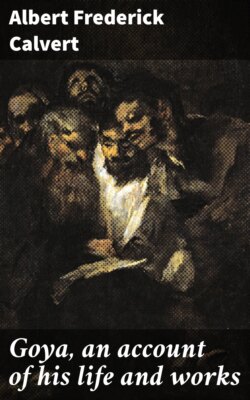Читать книгу Goya, an account of his life and works - Albert Frederick Calvert - Страница 3
На сайте Литреса книга снята с продажи.
PREFACE
ОглавлениеTable of Contents
It has been said that in England everybody knows of Cervantes, but very few persons have more than a nodding acquaintance with Don Quixote, and Goya’s reputation in this country is even less securely founded. The great Aragonese is indeed little more than a name to the general public, and his work is literally unknown. Two little books—Mr. W. Rothenstein’s Goya, now out of print, and a monograph by Mr. Richard Muther in the Langham Series—are the only volumes in English dealing exclusively with a painter who for more than half a century might have been described, with more aptness than that with which the words were applied to Zurbarán, as ‘All Spain.’ As sincere a lover and as brilliant a transcriber of the beautiful as Watteau and Van Loo, a greater realist than Hogarth, and in portraiture second only to Velazquez, Goya stands out as the greatest artist Spain has produced since the death of the great Court painter of Philip IV.
The fact that Spanish art reflects the aspirations and is largely concerned with the representation of scenes selected by its chief patron, the Spanish Catholic Church, accounts, in some measure, for the lack of sympathy and appreciation with which it is regarded in this country, but this prejudice does not explain the neglect from which Goya has suffered. Goya, it is true, accepted commissions from the Church, but his religious subjects do not comprise a tenth of his canvases, and in his etchings and engravings he is seen only as a secular moralist. As the painter of the Spanish Rococo period, he dipped his brush in beauty, gaiety, and humour; as a portraitist he was vivid, surprising, audacious, a maker of masterpieces; while his etchings constitute an unrivalled commentary upon the spirit of the age, recorded by its ‘most fearless and advanced thinker.’
Goya’s art would appear to be the reflection of his life. His youth was disordered and tempestuous; in the height of his success he accepted favours, but he was too conscientious an artist to repay the adulation of the world by flattering it in his canvases; and he published his disillusions in the biting satire of his Caprices and Proverbs.
The authorities I have consulted would make a formidable list, but among those to whom I am under special obligation I must mention the ‘Lives’ of Goya by the Conde de la Viñaza, Paul Lefort, Paul Lafond, W. Rothenstein, Richard Muther and Julius Hofmann; Valerian von Loga’s works on Goya’s etchings and engravings; Don Juan de la Rada’s chapter on ‘Goya’s Frescoes in the Church of San Antonio de la Florida;’ Muther’s appreciation of Goya in his History of Modern Painting; Stirling-Maxwell’s Annals of the Artists of Spain; Carl Justi’s ‘Sketch of Spanish Art’ in Baedeker’s Spain and Portugal; C. Gasquoine Hartley’s Spanish Painting; the Boletin de la Sociedad Española de Excursiones; and Théophile Gautier’s brilliant study of Goya in his Travels in Spain.
In making the collection of Goya’s works that is presented at the end of this volume, I have taken the line of least resistance and included reproductions of every picture, etching, or lithograph that I could acquire. However inadequate photography and ‘process’ may be to convey an impression of the original works, I have endeavoured to give English students an opportunity of becoming acquainted with the subjects and general nature of much of the output of Goya’s sixty years of artistic effort.
In the compilation of the appended exhaustive catalogue of Goya’s works, which I am not without hope may be found of practical value, I have derived no little assistance from Spanish and German publications and from the list prepared by M. Paul Lafond. To Señor Don Mariano Moreno, who has made a special study of Goya and his work, I am indebted for descriptions of many pictures which are published here for the first time, and my thanks are also due to him for permission to reproduce from his collection a number of photographs which were new to me. I have also to acknowledge the kindness of the authorities of the Academy of San Fernando in allowing me to publish copies of the different prints of Goya’s works issued by the Academy; and to express my thanks to Señor Don J. Lacoste, Messrs. Braun, Clement and Co., Messrs. Mansell and Co., and Herr Franz Hanfstaengl, for their courtesy in supplying me with various pictures included in this collection and permitting me to reproduce them.
A. F. C.
